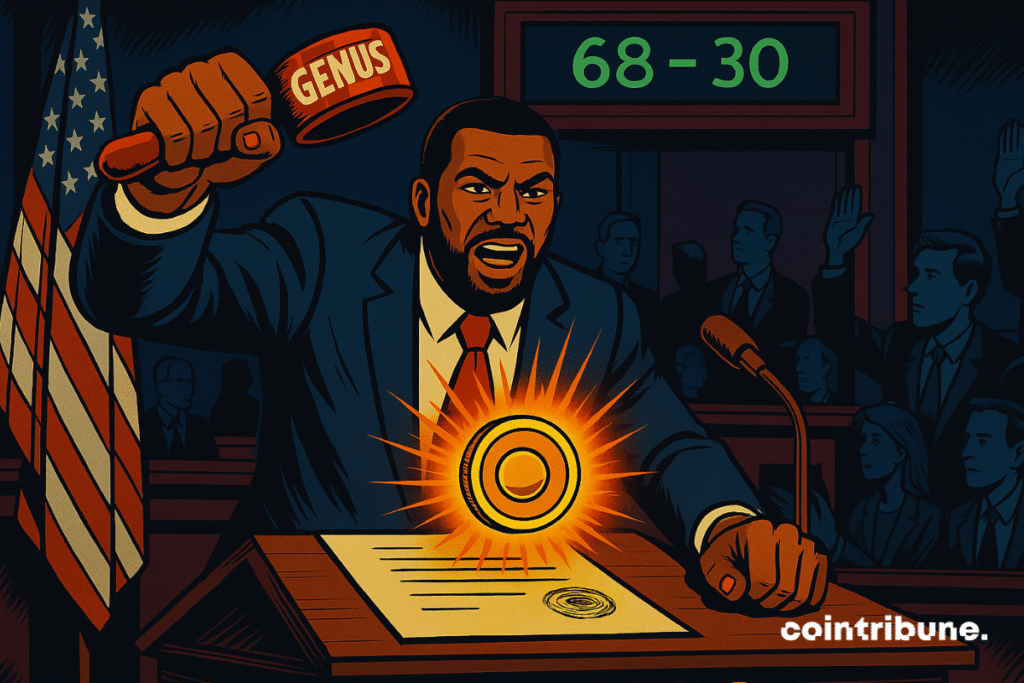12h05 ▪
5
min read ▪ by
The United States has just engraved a decisive page of modern monetary history into their legislative stone. By approving the GENIUS Act, the US Senate formalizes the entry of the tokenized dollar into legality. This is a turning point for digital finance and a strong signal sent to the rest of the world: the leading economic power is finally organizing itself around stablecoins, those tokens backed by the dollar that are disrupting payments, exchanges, and monetary sovereignty. Let’s take a look at the key highlights of this advancement.

In Brief
The Senate adopts the GENIUS Act, the first federal legal framework dedicated to stablecoins.
Each stablecoin must be backed by the dollar and audited monthly.
Banks, fintechs, and regulated merchants can now legally issue their own stablecoins.
GENIUS Act: Stablecoins Gain Their Official Framework
On June 11, 2025, the US Senate voted by 68 to 30 to initiate the procedure for adopting the GENIUS Act (Guiding and Establishing National Innovation for US Stablecoins Act). This initial vote was not yet a definitive adoption, but a closing vote. It aimed to block filibusters, these parliamentary obstruction tactics, and to allow a final vote to take place.
The final vote was held a few days later, confirming by the same score its adoption in plenary session, an essential step to officially send the text to the House of Representatives. The Senate has therefore established a national framework for stablecoins, these dollar-indexed crypto-assets.
The obligations are clear: each token must be backed 100% by a dollar reserve, verified by monthly audits. Moreover, any issuer must comply with anti-money laundering (AML) and Know Your Customer (KYC) regulations. The initiative covers banks, fintechs, and also commerce giants, provided they are regulated. Large non-financial tech companies, however, will not be able to issue stablecoins directly.
The text specifies:
The issuer of which – is obligated to convert, redeem, or repurchase for a fixed amount of monetary value.
These few words spell revolution. Gone is the regulatory uncertainty, making way for an architecture where the digital dollar can coexist with the crypto economy, without antagonism.
Political Power and Crypto Empire: The Flip Side of the American Dream
Behind the institutional momentum lies a more troubled dynamic. The GENIUS Act is also an electoral and financial stake for Donald Trump. In 2024, he received 57 million dollars through World Liberty Financial and holds nearly 16 billion WLFI tokens, according to his financial disclosure. Part of this income comes from sales of tokens linked to the presidential image.
The original draft wanted to prohibit any federal elected official and their families from profiting from stablecoins. This amendment was never put to a vote. Democrats denounce a maneuver orchestrated to legitimize Trump’s crypto affairs.
Criticism also erupted over the method. The project first failed in the Senate before returning after intense negotiations.
Nevertheless, despite the tensions, the text passed. Proof that crypto interests are carving a path into political machinery.
Stablecoins Redefine the Power of the Digital Dollar
Stablecoins are no longer just geek tokens. They have become strategic tools, used by payment giants and banks themselves.
Key figures:
28 trillion dollars in stablecoin transaction volume in 2023, according to Deutsche Bank;
More than 86% of the stablecoin market is dollar-indexed (USDC, USDT), according to DefiLlama;
250 million dollars invested by the crypto sector to support the 2024 Congress, according to analysts;
JPMorgan launches JPMD, a deposit token issued on Base (Coinbase), aimed at institutional investors;
Shopify, through Coinbase and Stripe, already offers payments in USDC on its platform.
Adoption is very real. Even OKX USA’s boss, Roshan Robert, welcomes a turning point:
The law creates a vital bridge to explore blockchain-powered payments.
Stablecoins are becoming the interface between traditional finance and crypto innovation.
According to Mike Cahill of Douro Labs, “If the U.S. gets this right, it won’t just lead the crypto market — it will write the rulebook for the next global financial system“.
The world buzzes with rumors about the end of the dollar’s hegemony. Some speak of dedollarization, others of the rise of the digital yuan. But another path is opening: the stablecoin dollar. It is programmable, traceable, and now backed by federal law. A strategic tool. And perhaps, the ultimate mutation of an aging currency. This is not investment advice.
Maximize your Cointribune experience with our “Read to Earn” program! For every article you read, earn points and access exclusive rewards. Sign up now and start earning benefits.
La révolution blockchain et crypto est en marche ! Et le jour où les impacts se feront ressentir sur l’économie la plus vulnérable de ce Monde, contre toute espérance, je dirai que j’y étais pour quelque chose
DISCLAIMER
The views, thoughts, and opinions expressed in this article belong solely to the author, and should not be taken as investment advice. Do your own research before taking any investment decisions.




